For his first solo exhibition in the United States at Sean Kelly in New York (jing-atmospheres, 5 November–18 December 2021), Taiwanese artist Wu Chi-Tsung reimagines traditional Chinese landscape painting through film, installation, and photography.
Within this stunning, formally innovative body of works, his ‘Cyano-Collage’ series (2021) utilises Xuan paper treated with photosensitive coating and hung outside to expose them to sunlight. After developing the papers under liquid, the artist combines and mounts them on aluminium.
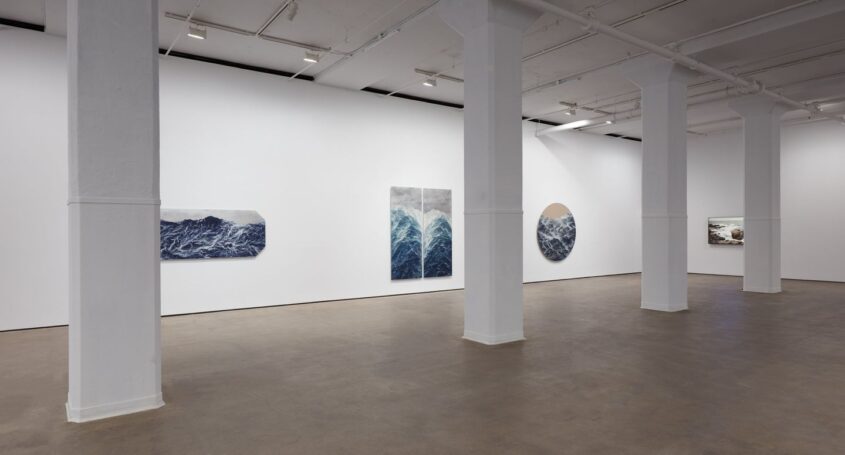
Each work in the series contains multiple pieces of Xuan paper, seamlessly collaged into unified compositions with no discernable boundaries. Cyano-Collage 120, for example, resembles a monumental painting of the ocean with thunderous, cerulean waves. These five ‘Cyano-Collage’ works range in size, though the largest ones span entire walls. (The artist built a vast studio to produce this series.) To complete their surfaces, Chi-Tsung applies white acrylic as a mist, which lends a sense of depth to the landscapes. Sometimes this spectral white acrylic resembles an intense energy surge. The beauty of these cyanotype collages is that they are both hyper-realistic and indeterminable, resisting any fixed reading.
‘They could be anything, because they are not representing any real landscape’, the artist has explained. ‘This is the spirit of a Chinese landscape.’
The ‘Cyano-Collage’ works are based on Chinese shan shui paintings, which literally translates to ‘mountain-water-pictures’. And like shan shui, which do not follow Western linear perspective, the ‘Cyano-Collage’ works encourage mobile viewing, inviting the eye to move around the work and construct the image in the process.
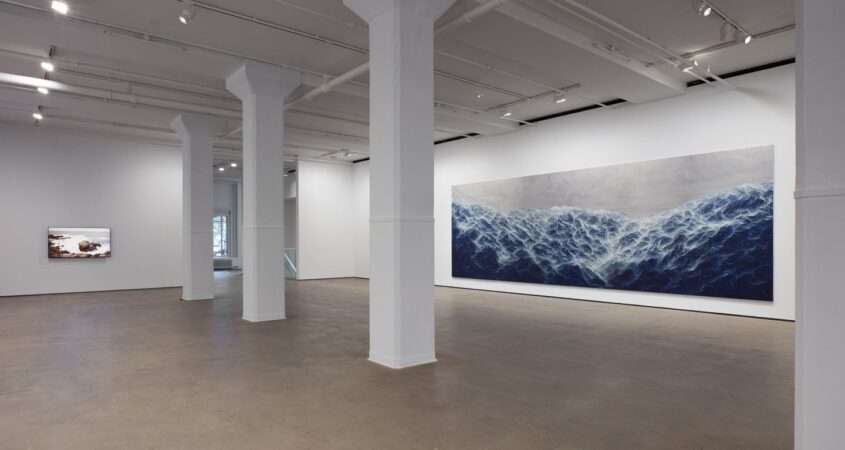
Formally trained in Chinese calligraphy and ink art, Chi-Tsung explores the essence of Chinese landscape painting and what it might offer the viewer. In 2012, he turned to photography to do this. Unsatisfied with the medium’s contemporary formats, Chi-Tsung turned to cyanotype—a method that has been used since the mid-1800s.Various artists, most notably Robert Rauschenberg early in his career, have experimented with the cyanotype process. Drawn to its use of light rather than the dark room, the sun is as important a material to Chi-Tsung as Xuan paper.
Developing the images by exposing them to sunlight, cyanotype offers Chi-Tsung a time- and chance-based process, with the paper’s crumpled surface encouraging different tonalities.
‘The best works,’ the artist has noted, ‘always come from some kind of coincidence . . . Most artists have a strong ego. We try to control our work. But the more you try to control it, the more likely you lose the possibility. Let the work grow in the way it should.’
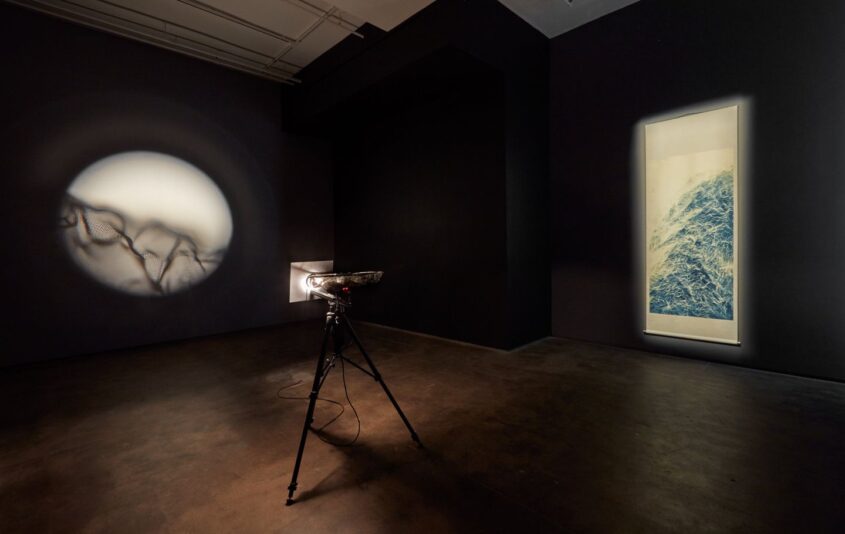
While invigorating the Chinese landscape tradition, cyanotypes also offer an exercise in ego depletion, with Chu-Tsing relinquishing control to put faith in the material instead.
The artist’s deference to the life and agency of materials is also evident in the installation Dust (2006), situated in the lower level of the gallery. A camera is positioned at one end of the darkened room with its lens focused on the light of a projector installed at the opposite end.
The camera feeds a live video signal to the projector, which projects this recording of the circulation of dust particles in the room onto the wall behind the camera. As viewers move through the space, they disrupt and speed up the flickering and glimmering of the enlarged dust particles projected on the wall.The result is unexpectedly spiritual: an effervescent projection of colourful, shimmering dots that swirl and move energetically in an otherworldly ambiance.Particles of dust are transformed into an entire cosmos. The material here is not only the technological support of the camera and projector, but also dust itself—something so banal and ubiquitous that Chi-Tsung animates with life and verve of its own.
Chi-Tsung refers to the Buddhist term zi xing (自性), which translates to ‘self-being’, or one’s own nature. ‘If I could just lower my ego,’ he says, ‘and let the material show what it is, at the same time I could get real freedom through that. In this way I am helping the material to find its own being.’
The brilliance of Chi-Tsung’s works lies in the fact that he elevates materials—dust, Xuan paper, and sunlight—beyond human meanings and uses, with an unerring sense that the material is as in control of the final outcome as the artist himself.
By Emily Chun
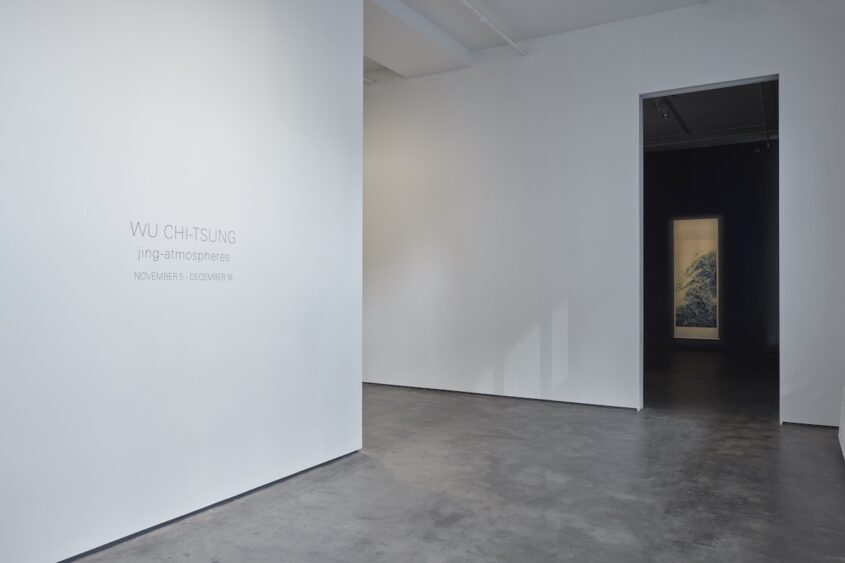
正在尚·凱利畫廊舉辦的「境」(展期:2021 年 11 月 5 日至 12 月 18 日),是臺灣藝術家吳季璁在美國的首次個展。他將中國傳統山水畫的概念轉譯為電影、裝置和攝影的當代語言,產生了形式創新的驚艷作品。新作「氰山集」系列(均作於 2021 年)由八個叠代作品組成。
例如,《氰山集之一百二十》(2021)乍一看是一幅巨大的海景畫,上面有雷鳴般的青色波浪,但仔細一看卻是宣紙上的氰版拼貼。為了製作這些作品,吳季璁把經過感光塗劑處理的宣紙揉皺,然後把它們掛在外面暴曬。在液體下對這些紙進行顯影後,藝術家將多張紙組合在一起並裱在鋁板上。
該系列的每件作品都包含幾十張宣紙,他花了一年多時間集齊這些宣紙,看起來拼貼得天衣無縫,聚合成完全統一、看不出邊界的構圖。八件氰版拼貼作品大小不一,最大的作品占據了一整面墻。(為了創作這一系列作品,藝術家搭建了一個有高天花板和開放空間的新工作室。)
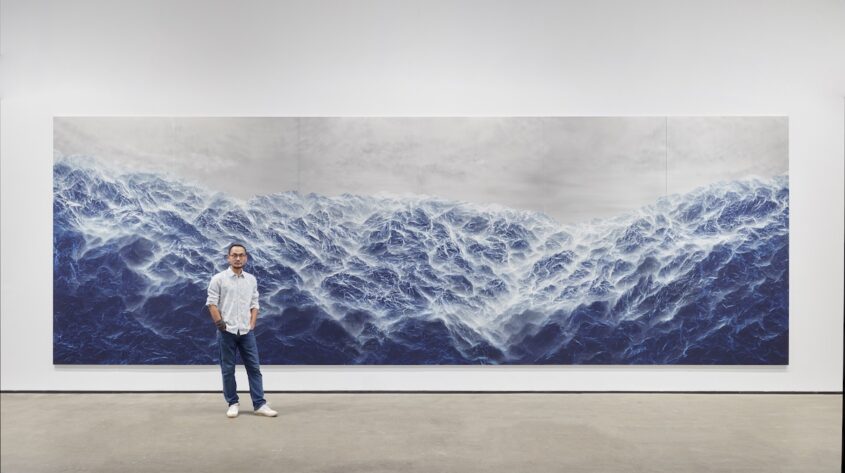
Courtesy Sean Kelly, New York. Photo: Jason Wyche, New York.
這些作品頗富紋理的表面開啟了自然現象的諸多可能:如前所述,這些作品與劇烈的海浪或漩渦最為相似,但從另一角度看,它們也令人想起冰山或地質巖。在對這些作品進行最後潤色時,吳季璁塗抹了一層如同霧氣的白色丙烯,使表面生動起來,風景有了深度感。
有時,這縹緲的白色丙烯也像是閃電或某種強烈的能量,湧動在山地景觀中。這些氰版拼貼作品的美妙之處在於,它們是超寫實的,但卻不是任何特定物的寫實,它們不會泄露自己描繪的內容。像所有好的藝術一樣,它們顛覆了任何先入為主的知識或人們一開始認定它是什麽(對我來說是海浪)的信心。正如吳季璁所說:「它們可以是任何東西,因為它們不代表任何真實的風景。這就是中國山水的精神。」
「氰山集」以山水畫為基礎。如同山水一樣,這些作品不遵循西方的線性透視系統和固定的視線,而是創造崇高的、令人沈浸其中的構圖,引得視線在作品周圍移動,並在移動過程中構建出圖像,因為它們不屈從於單一的透視滅點。吳季璁從小接受書法、水墨和素描的正式訓練,他更感興趣的是山水畫的精神和本質,以及它能為觀者提供怎樣的空間體驗,而非嚴格遵守某些執行方式。
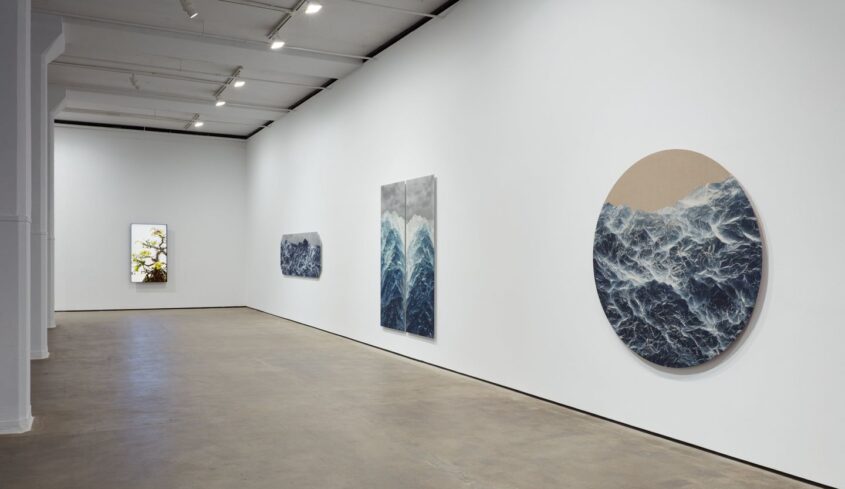
吳季璁 2012年開始製作氰版作品,因為不滿於目前大多數的攝影模式,他轉向了早期的攝影技術,特別是自 19 世紀中期以來一直在使用的氰版攝影。氰版因其高度實驗性的特質,曾被眾多藝術家所用,尤為矚目的是羅伯特·勞森伯格(Robert Rauschenberg)1950 年代在其藝術生涯早期的創作。
吳季璁被氰版在陽光下的作用所吸引,意識到這違背了他對攝影的期望,因為傳統攝影總是在暗室或黑箱中進行。對他來說,太陽和宣紙本身一樣是一種重要的媒介。藝術家指出:「最好的作品總是來自某種巧合……大多數藝術家都有強烈的自我意識。我們試圖控製自己的作品,但越是試圖控製它,就越會失去可能性。要讓作品以它該有的方式成長。」
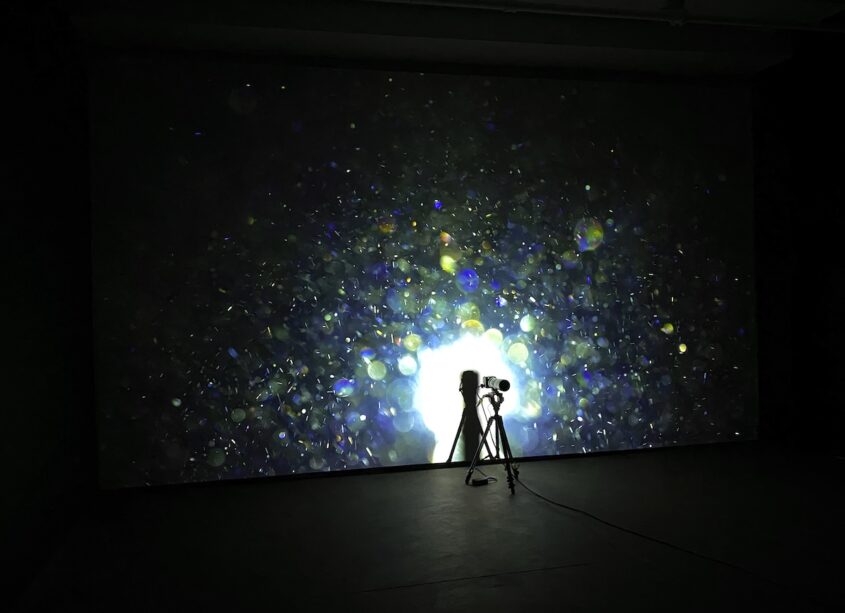
使用氰版工作不僅是吳季璁用創新技術為山水傳統註入活力的一種方式。也是對自我的一種鍛煉,一個放棄藝術控製的機會,信任材料的自我生長,「以它該有的方式」。藝術家對材料生命和作用的尊重同樣體現在位於畫廊下層的裝置作品《灰塵》(2006)中。
昏暗的房間裏,一端放置著攝像機,鏡頭對準了另一端的投影儀光源。攝像機將實時視頻信號傳送給投影儀,投影儀將房間裏灰塵顆粒的遊走投射到攝像機後面的墻上。觀眾在空間中移動時,他們擾亂並加速了投射在墻上、被放大的灰塵顆粒的閃爍和亮光。
如果這在技術上聽起來很深奧,那麽其結果卻有著驚人的靈性:五光十色的閃爍小點在異世界的氛圍中活力四射地旋轉和移動,塵粒化為整個宇宙。這裏的材料不僅僅是攝像機和投影儀的技術支持,還有灰塵本身——它是如此平庸和無處不在的東西,而吳季璁用灰塵的生命和活力令作品生動起來。
其實,材料和藝術家本人一樣控製著最終結果。
文/ Emily Chun
譯/ 鐘山雨